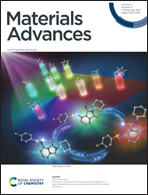Surface-initiated polymerization of mussel-inspired dopamine for hydrophilic coatings†
Abstract
Inspired by mussels, dopamine with catechol and amino groups in the molecular structure has been broadly studied for its universal attachment, biocompatibility and ease of use. Dopamine is known to undergo autoxidation in the presence of oxygen and transform polydopamine particles. This method utilizes a rapid redox reaction to polymerize dopamine; however, there are some disadvantages, such as difficulty in controlling the reaction, appearance of homopolymers in solution, unstoppable polymerization and so on, resulting in little industrial or commercial development of dopamine-based surface coatings. In this study, we carried out free-radical polymerization of dopamine. Via this unorthodox method, a very thin polydopamine-modified coating can be fabricated. It can produce a reaction localized on the surface to functionalize or modify it, making it a promising tool for surface modification.



 Please wait while we load your content...
Please wait while we load your content...